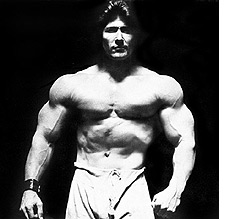 Since it's been previously covered the not-too-distant past, I was a little surprised to see someone asking about it again recently. Either I wasn't through or I need to start tagging. Either way, I can talk about this some more.
Since it's been previously covered the not-too-distant past, I was a little surprised to see someone asking about it again recently. Either I wasn't through or I need to start tagging. Either way, I can talk about this some more. Some trainers and trainees out there do a really good job of turning training into a veritable theater production, complete with the warm-up act, stretches/foam-rolling/whatever act, the workout act, the cool-down act, more stretches/foam-rolling/whatever act, then cardio act (or does that go in the beginning?), then whatever-else act... Could they possibly make this more complicated? Complication takes too much time. Is this stuff necessary? I really have my doubts. Even if I'm wrong about how effective all of this is, it doesn't really matter. You and I don't have the time and what's better: 30 minutes of (supposedly) incomplete, (maybe) half-ass training or none at all?
I don't think that 15-30 minutes of training time dooms the workout to being half-assed or incomplete at all. There are a surprising number of people that don't get a lot of attention for using such brief training sessions and gotten great results. I certainly have. If anything, I look at it as ultra-efficiency at it's best, not as a measuring stick of dedication or effectiveness.
I've never been a fan of doing the typical sets of reps training stuff. It just takes up too much time. For the past couple of years, I've been doing nearly every workout circuit-style. I'd rather work my ass off on one exercise and move to something else that I haven't worked out. Sure, I might pause for a bit in between but I'm not really "resting." I'll usually take a minute of rest after the circuit is completed. I'll mix it up between supersetting a lot, mostly with my pulls & chins and push-ups/dips. I also like to do a lot of sandbag squat-and-carry work.
Structure is important to shaving time off the time-crunched workout. Keeping the rest down is paramount. You've to to do everything possible to push the pace and keep moving. That's really the most important part. You can rest after you finish up! When I work out, I pause for maybe 30 seconds between exercises and about a minute in between circiuts, at most. Anything more than that is wasting a lot of time un-necessarily. Besides, there's some very convincing evidence that the abbreviated rest periods are better overall for you anyway. I recently read that Don Howorth used to rest even less than my self-imposed 30 seconds. Moving this fast won't make you miss the extra 30 minutes of rest in the workout. If anything, I see this move as maximizing efficiency of the entire workout.
 30 seconds of rest per set, 45 minutes total workout time built this!
30 seconds of rest per set, 45 minutes total workout time built this!There are other ways to make your workout more time efficient. Make sure that you're properly hydrated before you start. Get all your gear prepped and ready to go. Have a solid idea of what you're going to do before you start. If something's taking up a lot of time, ask yourself if it's really needed.
I've given some of my routines out in the past. I'm not the fondest of doing it though. I really believe in being self-observant and introspective. Experiment for yourself and work with what you have available. Cutters good for cookies, not training. I've given you some guidelines and tips. It's up to you to make them into something that will work for you. It's really that simple.














